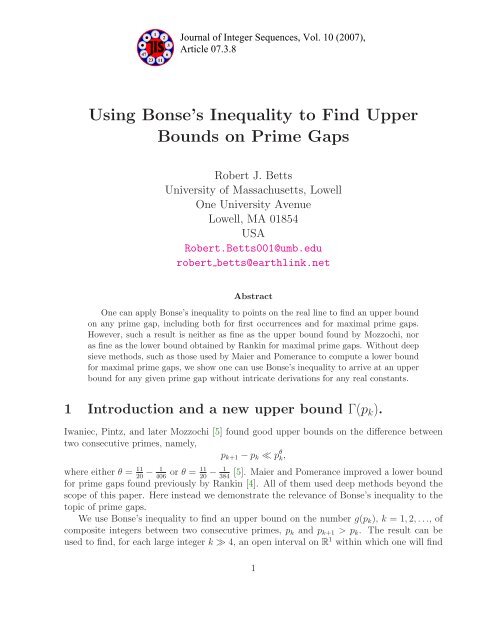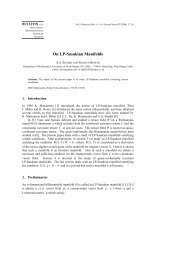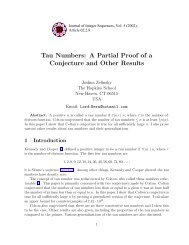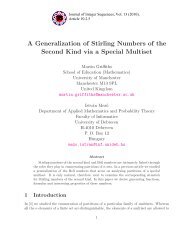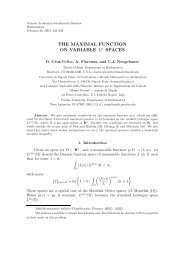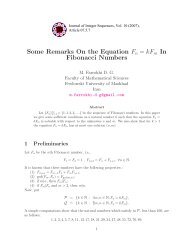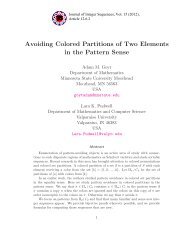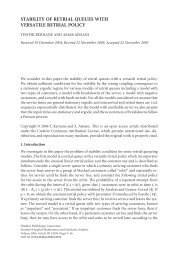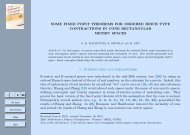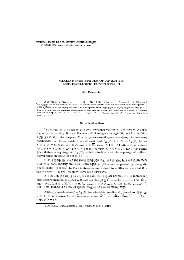Using Bonse's Inequality to Find Upper Bounds on Prime Gaps
Using Bonse's Inequality to Find Upper Bounds on Prime Gaps
Using Bonse's Inequality to Find Upper Bounds on Prime Gaps
Create successful ePaper yourself
Turn your PDF publications into a flip-book with our unique Google optimized e-Paper software.
12347 623 11Journal of Integer Sequences, Vol. 10 (2007),Article 07.3.8<str<strong>on</strong>g>Using</str<strong>on</strong>g> B<strong>on</strong>se’s <str<strong>on</strong>g>Inequality</str<strong>on</strong>g> <str<strong>on</strong>g>to</str<strong>on</strong>g> <str<strong>on</strong>g>Find</str<strong>on</strong>g> <str<strong>on</strong>g>Upper</str<strong>on</strong>g><str<strong>on</strong>g>Bounds</str<strong>on</strong>g> <strong>on</strong> <strong>Prime</strong> <strong>Gaps</strong>Robert J. BettsUniversity of Massachusetts, LowellOne University AvenueLowell, MA 01854USARobert.Betts001@umb.edurobert betts@earthlink.netAbstractOne can apply B<strong>on</strong>se’s inequality <str<strong>on</strong>g>to</str<strong>on</strong>g> points <strong>on</strong> the real line <str<strong>on</strong>g>to</str<strong>on</strong>g> find an upper bound<strong>on</strong> any prime gap, including both for first occurrences and for maximal prime gaps.However, such a result is neither as fine as the upper bound found by Mozzochi, noras fine as the lower bound obtained by Rankin for maximal prime gaps. Without deepsieve methods, such as those used by Maier and Pomerance <str<strong>on</strong>g>to</str<strong>on</strong>g> compute a lower boundfor maximal prime gaps, we show <strong>on</strong>e can use B<strong>on</strong>se’s inequality <str<strong>on</strong>g>to</str<strong>on</strong>g> arrive at an upperbound for any given prime gap without intricate derivati<strong>on</strong>s for any real c<strong>on</strong>stants.1 Introducti<strong>on</strong> and a new upper bound Γ(p k ).Iwaniec, Pintz, and later Mozzochi [5] found good upper bounds <strong>on</strong> the difference betweentwo c<strong>on</strong>secutive primes, namely,p k+1 − p k ≪ p θ k,where either θ = 11 − 1 11or θ = − 1 [5]. Maier and Pomerance improved a lower bound20 406 20 384for prime gaps found previously by Rankin [4]. All of them used deep methods bey<strong>on</strong>d thescope of this paper. Here instead we dem<strong>on</strong>strate the relevance of B<strong>on</strong>se’s inequality <str<strong>on</strong>g>to</str<strong>on</strong>g> the<str<strong>on</strong>g>to</str<strong>on</strong>g>pic of prime gaps.We use B<strong>on</strong>se’s inequality <str<strong>on</strong>g>to</str<strong>on</strong>g> find an upper bound <strong>on</strong> the number g(p k ), k = 1, 2,..., ofcomposite integers between two c<strong>on</strong>secutive primes, p k and p k+1 > p k . The result can beused <str<strong>on</strong>g>to</str<strong>on</strong>g> find, for each large integer k ≫ 4, an open interval <strong>on</strong> R 1 within which <strong>on</strong>e will find1
the real value for the prime gap. We also remark in Secti<strong>on</strong> 2, that computer work can bed<strong>on</strong>e <strong>on</strong> comparing the rate of growth of the upper bound <strong>on</strong> g(p k ) we found and the rate ofgrowth of (log(p k )) 2 as k → ∞, which by Cramér’s c<strong>on</strong>jecture, is the asymp<str<strong>on</strong>g>to</str<strong>on</strong>g>tic limit for amaximal prime gap whenever k is a very large integer. The sequence of prime gaps is related<str<strong>on</strong>g>to</str<strong>on</strong>g> the sequence of prime differences [9].Let∆p k = p k+1 − p k (1)denote the prime difference functi<strong>on</strong>, andg(p k ) = p k+1 − p k − 1 (2)the prime gap, meaning the number of c<strong>on</strong>secutive composites between the c<strong>on</strong>secutiveprimes p k+1 and p k . We show that for large integer k ≫ 4, such that the c<strong>on</strong>secutive primesp k ,p k+1 are very large, there exists an infinite sequence {Γ(p k )} ∞ k=1 , such that each termΓ(p k ) := p k( ∏ k−1i=1 p i − p k )log((k + 1) k+1 k k ) − 1 (3)> g(p k ),is an upper bound for each term g(p k ) that appears in the infinite sequence {g(p k )} ∞ k=1 ofprime gaps. However the result is not for a least upper bound <strong>on</strong> prime gaps g(p k ). Thevalues Γ(p k ) also are an upper bound <strong>on</strong> the prime differences ∆p k . In additi<strong>on</strong> <strong>on</strong>e shouldbe able <str<strong>on</strong>g>to</str<strong>on</strong>g> show that each term in the sequence {Γ(p k )} ∞ k=1 is an upper bound <strong>on</strong> eachcorresp<strong>on</strong>ding term (i.e., for each k ≫ 4) in the sequence {log(p k ) 2 } ∞ k=1 , where Cramér’sc<strong>on</strong>jecture says that, for large k, K, maximal prime gaps G(p K ) — meaning maximal ifG(p K ) is a prime gap such that G(p K ) > g(p k ) for all k < K — approach the asymp<str<strong>on</strong>g>to</str<strong>on</strong>g>ticlimit (log(p k )) 2 .The graph for the prime difference functi<strong>on</strong> ∆p k resembles — at the very least — frequencyvs. time graphs in the field of signal processing [8] and Gaussian noise [6]. Ourtheorem below rests <strong>on</strong> the foundati<strong>on</strong>s of two previously proved propositi<strong>on</strong>s, which immediatelyfollow. One can prove B<strong>on</strong>se’s inequality as an exercise [3]. Uspensky and Heaslet [7]also discuss B<strong>on</strong>se’s inequality.Propositi<strong>on</strong> 1 (B<strong>on</strong>se’s inequality). For k > 4,p 2 k+1
For a proof, see Gioia [1]. Now we are ready <str<strong>on</strong>g>to</str<strong>on</strong>g> prove a theorem that establishes theupper bound <strong>on</strong> g(p k ) through B<strong>on</strong>se’s inequality.Theorem 3. For k ≫ 4,g(p k ) < Γ(p k )= p k( ∏ k−1i=1 p i − p k )log((k + 1) k+1 k k ) − 1.Proof. By B<strong>on</strong>se’s inequality (Propositi<strong>on</strong> 1), when k ≥ 4,p 2 k < p 1 p 2 · · ·p k−1=⇒ p 2 k+1 − p 2 k < (p 1 p 2 · · ·p k ) − p 2 k=⇒ p k+1 − p k < p 1 · · ·p k − p 2 kp k+1 + p k= p k( ∏ k−1i=1 p i − p k ).p k+1 + p kNow when k ≫ 4 grows ever larger, it is true that p k ∼ k log k while by Propositi<strong>on</strong> 2, itremains true that ε = o(1), where ε = | p k−k log kp k| (See Table 1, and the proof by Gioia [1]of Propositi<strong>on</strong> 2). Furthermore, when k ≫ 4 grows larger it also follows from Propositi<strong>on</strong> 2and from the properties of logarithms thatwhere as k → ∞,p k+1 + p k ∼ (k + 1) log(k + 1) + k log k = log((k + 1) k+1 k k ),∣ (p k+1 + p k ) − log((k + 1) k+1 k k ) ∣∣∣∣= ε ′p k+1 + p k→ 0.Letting 0 ≤ ε ′ ≪ 1, that is, so that ε ′ ≈ 0, it follows that, as k → ∞,Then as k → ∞,p k ( ∏ k−1i=1 p i − p k )p k+1 + p kp k+1 − p k < p k( ∏ k−1i=1 p i − p k )p k+1 + p k∼ p k( ∏ k−1i=1 p i − p k )log((k + 1) k+1 k k ) . (4)∼ p k( ∏ k−1i=1 p i − p k )log((k + 1) k+1 k k ) , (5)where we have used Propositi<strong>on</strong>s 1 and 2. Then it follows that for large integer k ≫ 4 suchthat both p k ,p k+1 are very large,g(p k ) + 1 = p k+1 − p k= ∆p k< p k( ∏ k−1i=1 p i − p k )log((k + 1) k+1 k k ) ,=⇒ g(p k ) < Γ(p k ) = p k( ∏ k−1i=1 p i − p k )log((k + 1) k+1 k k ) − 1.3
2 The relati<strong>on</strong>ship log(Γ(p k )) has <str<strong>on</strong>g>to</str<strong>on</strong>g> the upper boundp 1120 −δkand other c<strong>on</strong>clusi<strong>on</strong>s.Table 1 suggests that our formula for Γ(p k ) indeed is an upper bound for g(p k ), as k getslarge. Also from Table 1 <strong>on</strong>e can see that the fast rate of increase of Γ(p k ) by far exceeds theslower rate of increase of (log(p k )) 2 . Hence it could be interesting <str<strong>on</strong>g>to</str<strong>on</strong>g> investigate by computerthe behavior of the three respective functi<strong>on</strong>s Γ(p k ), g(p k ) and (log(p k )) 2 , where (log(p k )) 2by Cramér’s c<strong>on</strong>jecture is such that for large k,gaps.Rankin [2] showed that there exists a real c<strong>on</strong>stant c such thatp k+1 −p k(log(p k )) 2 = O(1) is true for maximal primec(log k)(log log k)(log log log log k)(log log log k) 2 < p k+1 − p k . (6)Combined with the result from Theorem 3, this indicates that for large integer k ≫ 4, takenlarge enough so that p k and p k+1 both are very large, each term of the prime differencesequence ∆p k is bounded, for each such k, asc(log k)(log log k)(log log log log k)(log log log k) 2< p k+1 − p k< p k( ∏ k−1i=1 p i − p k )log((k + 1) k+1 k k ) = Γ(p k) + 1.Let, for some real c<strong>on</strong>stant c and for any fixed integer k = k 0 ≫ 4,a(k 0 ) = c log(k 0) log log(k 0 ) log log log log(k 0 )(log log log(k 0 )) 2 − 1, (7)b(k 0 ) = p k 0( ∏ k 0 −1i=1 p i − p k0 )log((k 0 + 1) k 0+1k k 00 ) − 1 = Γ(p k 0). (8)Then it follows from Theorem 3 that, for each such positive integer k = k 0 ≫ 4, the valuefor the prime gap g(p k0 ) lies inside an open interval (a(k 0 ),b(k 0 )) <strong>on</strong> the real line.Remarks: The upper bound Γ(p k ) found in Secti<strong>on</strong> 1 and which appears <strong>on</strong> the real linein Eq. 8 as b(k 0 ) for any large fixed integer k 0 ≫ 4 such that g(p k0 ) ∈ (a(k 0 ),b(k 0 )) ⊆ R 1 ,admittedly, is a large upper bound. This actually can be an advantage. We now can comparethe values of g(p k ) <str<strong>on</strong>g>to</str<strong>on</strong>g> those for log(Γ(p k ), log log(Γ(p k )) and log log log(Γ(p k )). In fact aninspecti<strong>on</strong> of Tables 2 and 3 shows it might be profitable <str<strong>on</strong>g>to</str<strong>on</strong>g> compare the values of log(Γ(p k )),log log(Γ(p k )) and log log log(Γ(p k )) <str<strong>on</strong>g>to</str<strong>on</strong>g> those for g(p k ), ∆p k and (log(p k )) 2 , whenever k > 4is large enough so that both p k and p k+1 are two very large c<strong>on</strong>secutive primes. This isbecause <strong>on</strong>e should be able <str<strong>on</strong>g>to</str<strong>on</strong>g> find by computer that log(Γ(p k )) > g(p k ), log(Γ(p k )) > ∆p kand log(Γ(p k )) > (log(p k )) 2 as k grows large, after which <strong>on</strong>e even might be able <str<strong>on</strong>g>to</str<strong>on</strong>g> prove4
that log(Γ(p k )) is a better upper bound <strong>on</strong> g(p k ) than is Γ(p k ), as k → ∞. In Table 3 thereader can compare the upper bound found by Iwaniec and Pintz [5],p 1120 −δ (9)with Γ(p k ), log(Γ(p k ) and log log(Γ(p k )), where in Table 3 we have allowed δ = 1 . As an406alternative <strong>on</strong>e could use the refinement found by Mozzochi, who found that, for real δ = 1 , 384p k+1 − p k ≪ p 1120 − 1384k. However a comparis<strong>on</strong> of column 3 and column 5 with column 9 inTable 3 elicits the following questi<strong>on</strong>:Does there exist, as k → ∞, a real c<strong>on</strong>stant α > 0, such thatg(p k ) = p k+1 − p k − 1 < log((log(Γ(p k )) α ) < p 1120 −δk− 1?Finally we can use the fact that the field of real numbers <strong>on</strong> the real line R 1 is closedfor the two binary operati<strong>on</strong>s (+, ×), <str<strong>on</strong>g>to</str<strong>on</strong>g> express the upper bound for prime gaps found byIwaniec and Pintz [5] for real δ = 1406 , by using log(Γ(p k)). Leta 1 ,a 2 ,..., (10)be an infinite sequence {a k } ∞ k=1of real numbers such thatp k = a k log(Γ(p k )) = log((Γ(p k )) a k). (11)Then we have at <strong>on</strong>cep 1120 −δk= (log((Γ(p k )) a k)) 1120 −δ (12)=⇒ g(p k ) ∈ (a(k),b ′ (k)) ⊆ R 1 , (13)where in Eq. (13) we have replaced a(k 0 ) in Eq. (7) with a(k) and, by utilizing the upperbound result found by Iwaniec and Pintz [5],b ′ (k) = p 1120 −δk(14)= (log((Γ(p k )) a k)) 1120 −δ . (15)In the following Tables 1–3, we have chosen δ = 1 , Iwaniec and Pintz’s [5] result) and406relative error (see [1, Theorem 45.3]).∣ ε =p k − k log k ∣∣∣∣→ 0. (16)p k5
k p k g(p k ) ∆p k (log(p k )) 2 k log k Γ(p k ) ε3 5 1 2 2.59... 3.27... −0.44... 0.34...4 7 3 4 3.79... 5.56... 10.85... 0.21...5 11 1 2 5.75... 8.00... 115.45... 0.27...6 13 3 4 6.58... 10.74... 1224.22... 0.17...7 17 1 2 8.03... 13.65... 16860.24... 0.19...Table 1k p k g(p k ) ∆p k (log(p k )) 2 Γ(p k ) log(Γ(p k )) log log(Γ(p k ))3 5 1 2 2.59... −0.44... ———– ——————4 7 3 4 3.79... 10.85... 2.38... 0.87...5 11 1 2 5.75... 115.45... 4.74... 1.55...6 13 3 4 6.58... 1224.32... 7.11... 1.96...7 17 1 2 8.03... 16860.24... 9.73... 2.28...Table 2k p k g(p k ) ∆p k p 1120 −δkΓ(p k ) log(Γ(p k )) a k log log(Γ(p k ))3 5 1 2 2.42... −0.44... ———– ———– ——————-4 7 3 4 2.90... 10.85... 2.38... 2.94... 0.87...5 11 1 2 3.72... 115.45... 4.74... 2.32... 1.55...6 13 3 4 4.07... 1224.32... 7.11... 1.83... 1.96...7 17 1 2 4.72... 16860.24... 9.73... 1.74... 2.28...Table 3References[1] A. Gioia, The Theory of Numbers: An Introducti<strong>on</strong>, Markham Publishing Company,1970.[2] R. Guy, Unsolved Problems in Number Theory, Sec<strong>on</strong>d Editi<strong>on</strong>, Springer-Verlag, 1994.[3] A. M. Kirch, Elementary Number Theory, Intext Educati<strong>on</strong>al Publishers, NY, 1974.[4] H. Maier and C. Pomerance, Unusually large gaps between c<strong>on</strong>secutive primes, Trans.Amer. Math. Soc., 322 (1990), 201–237.[5] C. J. Mozzochi, On the difference between c<strong>on</strong>secutive primes, J. Number Theory, 24(1986), 186–187.[6] T. Nicely, First occurrence prime gaps,http://www.trnicely.net/gaps/gaplist.html.[7] J. V. Uspensky and M. A. Heaslet, Elementary Number Theory, McGraw-Hill BookCompany, NY, 1939.6
[8] http://mathworld.wolfram.com/<strong>Prime</strong>DifferenceFuncti<strong>on</strong>.html.[9] N. J. A. Sloane, The On-Line Encyclopedia of Integer Seuqences,http://www.research.att.com/~njas/sequences/index.html.2000 Mathematics Subject Classificati<strong>on</strong>: Primary 11B05; Sec<strong>on</strong>dary 11B99.Keywords: B<strong>on</strong>se’s inequality, Cramér’s c<strong>on</strong>jecture, prime difference functi<strong>on</strong>, prime gap.(C<strong>on</strong>cerned with sequence A001223.)Received January 30 2007; revised versi<strong>on</strong> received April 13 2007. Published in Journal ofInteger Sequences, April 13 2007.Return <str<strong>on</strong>g>to</str<strong>on</strong>g> Journal of Integer Sequences home page.7


